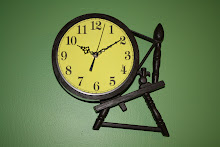I'm ready to start knitting the supposedly self-striping socks. Kate helped me pick some colors yesterday and I dyed the hanks.
The dying process was a little more troublesome than I expected. I think I need to work out a better way to dye the hanks separately while keeping them together. I ended up putting each hank in an old clean spagetti sauce jar and adding dye to the jars. Unfortunately, since I put the yarn in first, it was difficult to stir the dye to blend it and the colors didn't turn out as uniform as they should have. I then put all three jars in a pan in the oven at 200 degrees for an hour. After the yarn cooled, I rinsed it twice in water and synthropol and hung it up to air dry.
There was a significant white space between each hank (about 4 inches) and I dripped a good bit of candle wax at the middle of the white space to prevent the colors from bleeding over. Bleeding over wasn't really much of a problem though, and I ended up with white space and a lot of candle wax that is proving to be difficult to remove. Again, I think I'll have to think up something else next time.

On the positive side, the untangling of the skeins turned out to be fairly easy -- with patience. I laid each skein out in what I hoped was the same position as it had been on the warping board and began to wind it into a ball. With a few snags, much fewer than I had feared, I was able to wind it into a ball and then use my ball winder to make a center pull ball.

Now I'm ready to knit. I hope it makes reasonable stripes. Stay tuned for further developments!


